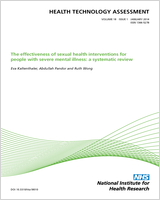Included under terms of UK Non-commercial Government License.
NCBI Bookshelf. A service of the National Library of Medicine, National Institutes of Health.
Headline
The review found insufficient evidence to recommend that pan-retinal photocoagulation is used at the non-proliferative stage of diabetic retinopathy.
Abstract
Background:
Diabetic retinopathy is an important cause of visual loss. Laser photocoagulation preserves vision in diabetic retinopathy but is currently used at the stage of proliferative diabetic retinopathy (PDR).
Objectives:
The primary aim was to assess the clinical effectiveness and cost-effectiveness of pan-retinal photocoagulation (PRP) given at the non-proliferative stage of diabetic retinopathy (NPDR) compared with waiting until the high-risk PDR (HR-PDR) stage was reached. There have been recent advances in laser photocoagulation techniques, and in the use of laser treatments combined with anti-vascular endothelial growth factor (VEGF) drugs or injected steroids. Our secondary questions were: (1) If PRP were to be used in NPDR, which form of laser treatment should be used? and (2) Is adjuvant therapy with intravitreal drugs clinically effective and cost-effective in PRP?
Eligibility criteria:
Randomised controlled trials (RCTs) for efficacy but other designs also used.
Data sources:
MEDLINE and EMBASE to February 2014, Web of Science.
Review methods:
Systematic review and economic modelling.
Results:
The Early Treatment Diabetic Retinopathy Study (ETDRS), published in 1991, was the only trial designed to determine the best time to initiate PRP. It randomised one eye of 3711 patients with mild-to-severe NPDR or early PDR to early photocoagulation, and the other to deferral of PRP until HR-PDR developed. The risk of severe visual loss after 5 years for eyes assigned to PRP for NPDR or early PDR compared with deferral of PRP was reduced by 23% (relative risk 0.77, 99% confidence interval 0.56 to 1.06). However, the ETDRS did not provide results separately for NPDR and early PDR. In economic modelling, the base case found that early PRP could be more effective and less costly than deferred PRP. Sensitivity analyses gave similar results, with early PRP continuing to dominate or having low incremental cost-effectiveness ratio. However, there are substantial uncertainties. For our secondary aims we found 12 trials of lasers in DR, with 982 patients in total, ranging from 40 to 150. Most were in PDR but five included some patients with severe NPDR. Three compared multi-spot pattern lasers against argon laser. RCTs comparing laser applied in a lighter manner (less-intensive burns) with conventional methods (more intense burns) reported little difference in efficacy but fewer adverse effects. One RCT suggested that selective laser treatment targeting only ischaemic areas was effective. Observational studies showed that the most important adverse effect of PRP was macular oedema (MO), which can cause visual impairment, usually temporary. Ten trials of laser and anti-VEGF or steroid drug combinations were consistent in reporting a reduction in risk of PRP-induced MO.
Limitation:
The current evidence is insufficient to recommend PRP for severe NPDR.
Conclusions:
There is, as yet, no convincing evidence that modern laser systems are more effective than the argon laser used in ETDRS, but they appear to have fewer adverse effects. We recommend a trial of PRP for severe NPDR and early PDR compared with deferring PRP till the HR-PDR stage. The trial would use modern laser technologies, and investigate the value adjuvant prophylactic anti-VEGF or steroid drugs.
Study registration:
This study is registered as PROSPERO CRD42013005408.
Funding:
The National Institute for Health Research Health Technology Assessment programme.
Contents
- Plain English summary
- Scientific summary
- Chapter 1. Background
- Chapter 2. The landmark trials: Diabetic Retinopathy Study and Early Treatment Diabetic Retinopathy Study
- Chapter 3. Laser studies: efficacy and safety
- Chapter 4. Combined laser and drug studies
- Chapter 5. Systematic review of existing cost-effectiveness evidence
- Chapter 6. Prevalence, progression and implications for modelling
- Chapter 7. Model for assessing cost-effectiveness of pan-retinal photocoagulation for non-proliferative diabetic retinopathy
- Chapter 8. Discussion and research needs
- Acknowledgements
- References
- Appendix 1 Classification of diabetic retinopathy in the early treatment of diabetic retinopathy study
- Appendix 2 Search strategies
- Appendix 3 Major features of Early Treatment Diabetic Retinopathy Study early photocoagulation
- Appendix 4 Health-state transitions for the model (usual care and intervention)
- List of abbreviations
Article history
The research reported in this issue of the journal was funded by the HTA programme as project number 12/71/01. The contractual start date was in August 2013. The draft report began editorial review in March 2014 and was accepted for publication in March 2015. The authors have been wholly responsible for all data collection, analysis and interpretation, and for writing up their work. The HTA editors and publisher have tried to ensure the accuracy of the authors’ report and would like to thank the reviewers for their constructive comments on the draft document. However, they do not accept liability for damages or losses arising from material published in this report.
Declared competing interests of authors
none
- NLM CatalogRelated NLM Catalog Entries
- Pan-retinal photocoagulation and other forms of laser treatment and drug therapi...Pan-retinal photocoagulation and other forms of laser treatment and drug therapies for non-proliferative diabetic retinopathy: systematic review and economic evaluation
- Tibial nerve stimulation compared with sham to reduce incontinence in care home ...Tibial nerve stimulation compared with sham to reduce incontinence in care home residents: ELECTRIC RCT
- Active monitoring, radical prostatectomy and radical radiotherapy in PSA-detecte...Active monitoring, radical prostatectomy and radical radiotherapy in PSA-detected clinically localised prostate cancer: the ProtecT three-arm RCT
- Fall prevention interventions in primary care to reduce fractures and falls in p...Fall prevention interventions in primary care to reduce fractures and falls in people aged 70 years and over: the PreFIT three-arm cluster RCT
- A case management occupational health model to facilitate earlier return to work...A case management occupational health model to facilitate earlier return to work of NHS staff with common mental health disorders: a feasibility study
Your browsing activity is empty.
Activity recording is turned off.
See more...
